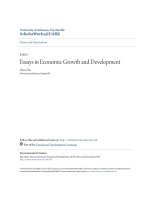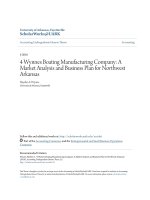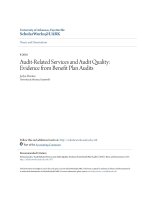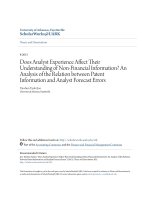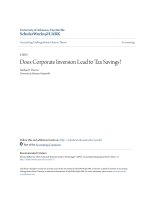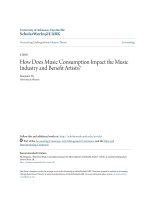Accounting undergraduate Honors theses: Donor and grantor reactions to CEO compensation in nonprofit organizations
Bạn đang xem bản rút gọn của tài liệu. Xem và tải ngay bản đầy đủ của tài liệu tại đây (1.61 MB, 87 trang )
University of Arkansas, Fayetteville
ScholarWorks@UARK
Theses and Dissertations
5-2014
Donor and Grantor Reactions to CEO
Compensation in Nonprofit Organizations
Stacey Renee Kaden
University of Arkansas, Fayetteville
Follow this and additional works at: />Part of the Accounting Commons, and the Organizational Behavior and Theory Commons
Recommended Citation
Kaden, Stacey Renee, "Donor and Grantor Reactions to CEO Compensation in Nonprofit Organizations" (2014). Theses and
Dissertations. 2348.
/>
This Dissertation is brought to you for free and open access by ScholarWorks@UARK. It has been accepted for inclusion in Theses and Dissertations by
an authorized administrator of ScholarWorks@UARK. For more information, please contact ,
Donor and Grantor Reactions to CEO Compensation in Nonprofit Organizations
Donor and Grantor Reactions to CEO Compensation in Nonprofit Organizations
A dissertation submitted in partial fulfillment
of the requirements for the degree of
Doctor of Philosophy in Business Administration
by
Stacey Kaden
Truman State University
Bachelor of Science in Accounting, 2003
Truman State University
Master of Accountancy, 2004
May 2014
University of Arkansas
This dissertation is approved for recommendation to the Graduate Council.
Dr. Gary Peters
Dissertation Director
Dr. Juan Manuel Sanchez
Committee Member
Dr. Junhee Han
Committee Member
ABSTRACT
Nonprofit organizations often rely on donations and grants to accomplish their mission.
This study examines whether nonprofit organizations with high CEO compensation receive less
in donor and grantor support compared to nonprofit organizations with lower CEO
compensation. I find strong evidence that both donors and grantors give less to organizations
that spend a larger percentage of total expenses on total CEO compensation. I also find that the
reactions of donors and grantors differ based on the type of CEO compensation. While donors
and grantors react to CEO base compensation, grantors also react to other CEO compensation
and nontaxable benefits.
In additional tests, I find strong evidence that the negative reaction of donors and grantors
is stronger when organizations have more sophisticated donors and grantors. I also find that the
relation between future contributions and CEO compensation is stronger in organizations that are
more reliant on contributions as a source of revenue. I do not find any evidence that the
reporting of CEO compensation expense as program related, management, or fundraising has any
effect on how donors and grantors respond to the percentage of expenses spent on CEO
compensation. I also do not find that the CEO serving on the board of directors changes how
donors and grantors respond to CEO compensation. Overall, my results suggest high
compensation to CEOs of nonprofit organizations can have adverse consequences to an
organization through reduced funding from donors and grantors.
ACKNOWLEDGEMENTS
I thank Gary Peters, Juan Manuel Sanchez, Linda Myers, and workshop participants at
the University of Arkansas for helpful suggestions and comments that have improved the paper.
I thank GuideStar for access to GuideStar Premium to assist with my research.
I am grateful to my wonderful husband, Ryan. He has supported me every step of this
journey – agreeing to move our family, helping at home and with our boys, reading my writing,
and encouraging me during the hard times. I thank my two boys, Jaxson and Harrison, for being
my motivation through this process. I thank my parents and Ryan’s parents for their support. I
thank Arnold Howell for his constant encouragement. I am grateful for my fellow PhD cohorts
who have made the experience all the more memorable, especially my officemate, “twin”, and
partner in all shenanigans, Lauren Dreher-Cunningham, and my former officemate, Jacob
Haislip.
I am grateful for the support from my dissertation committee, Gary Peters, Juan Manuel
Sanchez, and Junhee Han. I am thankful for Gary’s service as my chair and all of his advice and
suggestions. I am forever grateful for the support and mentoring Manuel has provided to me not
only with my dissertation but throughout my time in the PhD program. He is an invaluable
advisor and friend. I thank Junhee for his patience with us Accounting PhD students that
invaded his graduate statistics classes. He is an exceptional teacher.
TABLE OF CONTENTS
1. INTRODUCTION .........................................................................................................1
2. LITERATURE REVIEW AND HYPOTHESIS DEVELOPMENT .............................8
Prior Literature .........................................................................................................8
CEO Compensation ...............................................................................................12
Types of CEO Compensation ................................................................................13
Donor and Grantor Sophistication .........................................................................14
CEO on the Board ..................................................................................................15
Source of Revenue .................................................................................................16
CEO Salary Allocation ..........................................................................................17
Form 990 ................................................................................................................18
3. SAMPLE AND RESEARCH DESIGN.......................................................................20
Sample and Data Sources.......................................................................................20
CEO Compensation ...............................................................................................22
Types of CEO Compensation ................................................................................24
Donor and Grantor Sophistication .........................................................................25
CEO on the Board ..................................................................................................26
Source of Revenue .................................................................................................27
CEO Salary Allocation ..........................................................................................28
4. RESULTS ....................................................................................................................29
Descriptive Statistics ..............................................................................................29
Schedule J Descriptives .........................................................................................30
Correlations ............................................................................................................31
CEO Compensation ...............................................................................................31
Types of CEO Compensation ................................................................................33
Donor and Grantor Sophistication .........................................................................34
CEO on the Board ..................................................................................................36
Source of Revenue .................................................................................................36
CEO Salary Allocation ..........................................................................................39
Robustness Tests ....................................................................................................40
Additional Tests .....................................................................................................41
5. CONCLUSION ............................................................................................................42
REFERENCES ..................................................................................................................45
APPENDIX A: 2008 Form 990, Schedule J ......................................................................50
Page 1 .....................................................................................................................50
Page 2 .....................................................................................................................51
APPENDIX B: Variable Definitions .................................................................................52
1. INTRODUCTION
Executive compensation can be a controversial issue for stakeholders of nonprofit
organizations. Many donors and grantors contend that Chief Executive Officer (CEO)
compensation is too high at some nonprofit organizations (e.g., Perry 2010, Green 2012, Charity
Navigator 2013). This often stems from the belief that the resources spent on high compensation
are funneled away from activities directly related to the organization’s mission. Others believe
that CEOs should not be highly compensated because they work for a nonprofit organization
(e.g., Gose 2012a, Parker 2013). In this study, I examine whether CEO compensation affects the
donations and grants a nonprofit receives. If donors and grantors are sensitive to the amount of
compensation that nonprofit organizations pay their CEOs, I predict that organizations that spend
a higher percentage of their expenses on CEO compensation will receive less in donations and
grants compared to nonprofit organizations that spend a lower percentage.1 Additionally, I expect
the response to be conditional on the type of CEO compensation so I also examine whether
donors and grantors respond to the type and amount of compensation paid to the CEO, such as
bonuses or deferred compensation.2
Most donors and grantors contribute funds to nonprofit organizations to provide
resources to further the mission of the organization. However, because of agency costs, donors
and grantors lack confidence that the organization will use their funds for the purported mission
(Jensen and Meckling 1976, Hansmann 1980, Fama and Jensen 1983). Top management can
expropriate donations and grants for personal use through excessive salaries and perquisite
1
I examine the reaction of donors and grantors jointly and separately. I use the level of future
donation income to examine donor reaction and the level of future grant income to examine
grantor reaction. I use the level of total contributions – the combination of donations, grants, and
indirect donations – to examine donor and grantor reaction jointly.
2
Specifically, I examine CEO base compensation, incentive compensation, other compensation,
deferred compensation, and nontaxable benefits. I define these in Section 2.
1
consumption (Manne 1999, Krishnan et al. 2006). High profile scandals reported in the media
provide examples of how this expropriation occurs.3 Consider for example, the two founders of
The Young Adult Institute Network, a New York nonprofit organization operated to help the
developmentally disabled. They each earned close to one million dollars a year, drove luxury
automobiles financed by the organization, and had the organization pay their children’s college
tuition and over $50,000 in living expenses for one year for one child (Buettner 2011). This
controversy led the governor of New York to limit the amount of state funds that can be used to
pay nonprofit salaries (Gose 2012a). This example shows how serious a concern the agency
problem can be for donors and grantors and is consistent with prior research arguing that agency
problems can be more severe in nonprofit organizations (Fama and Jensen 1983, Manne 1999).
The primary source of disclosure about nonprofit organizations is the Internal Revenue
Service (IRS) Form 990. The IRS requires most organizations that are exempt from paying
federal income tax to file Form 990, an information return, with the IRS every year. Donors and
grantors have access to these returns because organizations must make them publicly available
and GuideStar, a charity watch organization, makes them available on their website.4 In 2008,
the IRS implemented new disclosure rules that increased and improved the reporting of
executive compensation information on the Form 990. The change in regulation requires
nonprofit organizations to report details about executive compensation not previously available,
including a breakdown of total compensation by type for each executive (Panepento and Kean
3
For examples of some high profile scandals involving nonprofit organizations, see Williams et
al. (2005) (American University), Perry (2007) (The Smithsonian Institution), Frazier (2009)
(United Way of Central Carolinas), and Buettner (2011) (The Young Adult Institute Network),
among others.
4
Donors and grantors can view these completed Form 990s for free at www.guidestar.org.
2
2008). I exploit the compensation information reported on the revised Form 990 to test my
research questions.
It is possible that donors and grantors may not respond to CEO compensation levels. The
median donation by an individual per charity is small and these individuals may not feel like the
size of their donation warrants extensive research of the nonprofit organization (Mulligan 2007).
Additionally, some donors and grantors may feel that high CEO compensation is necessary to
attract and retain high quality executives who are able to run large, complex nonprofit
organizations (Perry 2010, Parker 2013). Finally, some donors have internal motivations to give
such as personal ties or the “warm glow” they feel from giving (Hansmann 1980, Andreoni
1990, Gordon and Khumawala 1999). However, given that prior studies have found that
donations are sensitive to the disclosure of material weaknesses and governance quality
(Petrovits et al. 2011, Harris et al. 2014), it is reasonable to expect that donors and grantors react
to CEO compensation, a topic that receives significantly more media attention.
To address my research questions, I construct a sample of 501(c)(3) organizations from
2008 and 2009.5 I choose these years to take advantage of the compensation information now
available on the revised Form 990 to test several of my hypotheses. Since I am interested in the
level of donations and grants made to an organization the year after the disclosure of CEO
compensation details, for an organization to remain in my sample, it must have donation and
grant information available for 2009 and 2010. Additionally, future contributions, donations,
and grants must be at least one thousand dollars. After eliminating organizations that are not
required to disclose detailed compensation plan information and observations with missing data,
5
I focus on 501(c)(3) organizations because these public charities receive tax deductible
donations by donors. I construct my sample using information from 2008 through 2010 Form
990s, available on the IRS’s website.
3
the final sample contains 8,610 observations when future contributions is the dependent variable
and 8,174 (5,182) observations for tests involving donations (grants) as the dependent variable.
I find strong evidence that future contributions are lower for organizations that spend a
higher percentage of total expenses on total CEO compensation. When I examine the two major
components of future contributions – future donations and grants – I find that both are negatively
related to the percentage of total expenses spent on CEO compensation. These results indicate
that both donors and grantors are sensitive to the size of CEO compensation in relation to total
expenses of the organization. To better understand the implications of this result, consider two
organizations that pay their CEOs $500,000 in total compensation. The organization whose
CEO compensation is 2% of total expenses would receive less in contributions than the
organization whose CEO compensation is 1% of total expenses, all else being equal. These
results indicate that both donors and grantors penalize organizations with high CEO
compensation relative to total expenses by providing lower levels of funding.
In additional tests, I examine how donors and grantors react to the specific types of CEO
compensation. I decompose total CEO compensation into base compensation, incentive
compensation, other compensation, deferred compensation, and nontaxable benefits. Base
compensation includes salary while incentive compensation includes bonuses and other
contingent payments. Other compensation includes all other taxable compensation that must be
included on the CEO’s W-2.6 I find that future contributions are negatively related to the
percentage of total expenses spent on CEO base compensation, other compensation, and
6
Examples of payments included in this category are: severance payments, tax gross-ups paid,
vacation or sick leave cashed out, forgiveness of loan debt or interest, employee deferrals to
401(k) or 403(b) plans, taxable housing provided by the employer, employer-provided
automobile, and expenses paid on behalf of the executive such as personal legal services,
personal financial services, and social club dues. The types of CEO compensation are discussed
in more detail in Section 2.
4
nontaxable benefits. When I drill down to the donor level, I find that future donations are
negatively related to the percentage of total expenses spent on CEO base compensation. These
results indicate that donors penalize organizations that spend a high percentage of their expenses
on the CEO’s base compensation. Grantors appear to be influenced by more types of CEO
compensation than donors. I find that future grants are negatively related to the percentage of
expenses spent on base compensation, other compensation, and nontaxable benefits for the CEO.
The results indicate that grantors reduce grant awards, especially in response to high levels of
base compensation, other compensation, and nontaxable benefits.
Given the results of my main tests, I examine several instances where the reaction of
donors and grantors may be even stronger. Using the presence of, and level of, restricted net
assets to proxy for donor and grantor sophistication, I find strong evidence that the negative
reaction of donors and grantors is stronger when organizations have more sophisticated donors
and grantors. I also find that the relation between future contributions and CEO compensation is
stronger in organizations that are more reliant on contributions as a source of revenue. I do not
find any evidence that the reporting of CEO compensation expense as program, management, or
fundraising has any effect on how donors and grantors respond to the percentage of expenses
spent on CEO compensation. I also do not find that the CEO serving on the board of directors
changes how donors and grantors respond to CEO compensation.
In robustness tests, I create a measure of industry adjusted CEO compensation. To
control for the possibility that the percentage of expenses spent on CEO compensation is related
to the type of nonprofit organization, I calculate the median ratio of CEO compensation scaled
by total expenses for each nonprofit industry per year. I subtract the industry median for each
observation to calculate the industry adjusted CEO compensation ratio. I find consistent results
5
for total CEO compensation – future contributions, donations, and grants are negatively related
to industry adjusted total CEO compensation scaled by total expenses. I also find that donors
and grantors are sensitive to the same types of CEO compensation.
This study has several implications for nonprofit organizations, donors, grantors,
lawmakers, and regulators. First, we know that many stakeholders feel that the compensation of
nonprofit executives is high. Charity Navigator (2013), in its most recent nonprofit CEO
compensation study, recognized this sentiment and wrote “[w]e know that many donors continue
to be concerned by what they believe to be excessive charity CEO pay.” To the best of my
knowledge, there is only one other study examining whether CEO compensation affects donor
and grantor behavior across the broad spectrum of nonprofit organizations.7 These results should
be of interest to boards of directors of nonprofit organizations as they weigh the potential
consequences to an organization when setting and negotiating CEO compensation and its
specific characteristics.
While researchers have studied how executive compensation disclosure affects
stakeholders of for-profit firms, we do not know how stakeholders use compensation disclosures
in nonprofit firms. We know from research in the for-profit literature that CEO compensation
disclosure affects stakeholder behavior. DeFusco et al. (1990) find that shareholders react
positively and bondholders react negatively to the disclosure of CEO compensation that aligns
CEO’s incentives to shareholders. Similarly, Wei and Yermack (2011) find that shareholders
react negatively and bondholders react positively to the disclosure of CEO compensation that
aligns CEO’s incentives to bondholders. My study adds to the findings of this research by
7
In a related study, Balsam and Harris (2014) find that donors and grantors do not react to the
level of CEO compensation disclosed on Form 990. Their measure of compensation is unscaled
and they use a different model which may explain the difference in results.
6
showing that donors and grantors, important stakeholders of nonprofit firms, also react to the
disclosure of nonprofit executive compensation.
Most papers that examine donor and grantor reactions to expenditures in nonprofit
organizations have focused on the reported allocation of total expenses – either total program
related, total administrative, or total fundraising expenses (e.g. Weisbrod and Dominguez 1986,
Posnett and Sandler 1989, Tinkelman and Mankaney 2007). They frequently find that donations
and grants are sensitive to the amount of expenses spent in each of these categories. Given this
outcome, researchers also find evidence that nonprofit organizations manipulate the reporting of
these amounts to reflect more favorably on the organization (Krishnan et al. 2006, Tinkelman
and Mankaney 2007). Building on these previous studies, I go a step further and examine a
specific type of expense that donors and grantors may be sensitive to, something previous studies
have generally not done. Examining CEO compensation expense has the added benefit that the
reported amount should be relatively free of manipulation, avoiding a concern of the previous
studies examining reported expenses.8
In a related paper, Balsam and Harris (2014) examine how donors respond to media
coverage of and the Form 990 disclosure of CEO compensation in nonprofit organizations.9
They find that the percentage change in donations from t-1 to t+1 is negatively related to media
coverage of CEO compensation in t but not related to the level of CEO compensation disclosed
in the Form 990 in t. They do find that the percentage change in donations is negatively related
to the level of CEO compensation when an organization has more sophisticated donors. My
8
Reporting requirements for the revised Form 990 require that the portion of the CEO’s
compensation reported on the Form 990 that is taxable must match the Form W-2 that is filed
with the government every year, insuring more accurate reporting on the Form 990.
9
This is the only other paper I am aware of that examines donor reaction to CEO compensation
across a wide range of nonprofit organization types.
7
study differs from theirs in several ways. First, I use the level of future donations instead of
changes in donations between two years. This, plus other model choices, helps me achieve more
explanatory power with a higher adjusted R2 value. Second, I use the percentage of expenses
spent on CEO compensation instead of an unscaled measure of CEO compensation. This
provides a CEO compensation amount that is more useful to donors and grantors to evaluate and
compare against other nonprofit organizations. Finally, in all of my tests, I examine how
different circumstances may effect both donors and grantors, both separately and combined.
In the next section, I review the prior literature on nonprofit donor and grantor behavior
and develop my hypotheses. In Section 3, I discuss my sample selection and research design. I
present descriptive statistics and my empirical analysis in Section 4 and conclude in Section 5.
2. LITERATURE REVIEW AND HYPOTHESIS DEVELOPMENT
Prior Literature
The size of the nonprofit sector is substantial. The Urban Institute estimates that there
were approximately 1.58 million nonprofit organizations registered with the IRS in 2011,
representing a 21.5 percent increase in nonprofit organizations since 2001 (Pettijohn 2013). The
nonprofit sector has a significant impact on the overall economy of the United States (U.S.),
contributing $836.9 billion or 5.6 percent of gross domestic product to the economy in 2011
(Pettijohn 2013). Charitable contributions, which are a primary interest of this study, were
$316.23 billion in 2012 (Giving USA Foundation 2013).
With billions in contributions given to nonprofit organizations every year, it is important
to understand the agency problems that exist in these organizations (Jensen and Meckling 1976,
Fama and Jensen 1983). Agency problems arise because donors and grantors lack assurance that
8
top management will not expropriate their contributions for personal use (Hansmann 1980,
Krishnan et al. 2006). Expropriation can occur through excessive salaries and perquisite
consumption, pursuing personal goals that are not related to the organization’s mission, and
slacking on professional duties – all activities that consume funds that could instead be used to
further the organization’s mission (Manne 1999, Krishnan et al. 2006). Core et al. (2006) find
evidence consistent with this theory. They examine what happens in nonprofit organizations that
hold excess cash. They find that excess cash is negatively related to future program related
expenditures but positively related to future CEO compensation. Their findings suggest that
excess cash is more likely to be spent on CEO compensation than spent on expenses that are
directly related to furthering the organization’s mission.
Numerous examples of the agency problem in nonprofit organizations also appear in the
media. Consider for example, the two founders of The Young Adult Institute Network, a
nonprofit organization operated to help the developmentally disabled in New York. The
founders both earned close to one million dollars each year in compensation, drove luxury
automobiles paid for by the organization, and had the organization pay their children’s college
tuition and over $50,000 in living expenses for one year for one child (Buettner 2011). This
scandal, as well as others, highlights how executives can expropriate resources from the
nonprofit organizations they lead for personal use.10
Agency problems can be more severe for nonprofit organizations (Fama and Jensen 1983,
Manne 1999). In for-profit firms, residual claimants (common shareholders) benefit directly
from monitoring management, which in turn reduces agency costs (Jensen and Meckling 1976).
Nonprofit organizations lack residual claimants, making it unclear who fulfills the monitoring
10
For additional examples, see Williams et al. (2005), Perry (2007), and Frazier (2009) among
others.
9
role over these organizations (Core et al. 2006).11 Ultimately, the enforcement of nonprofit
organizations resides with the IRS or state attorney generals, but their enforcement activities
have historically been limited, often because of resource constraints (Hansmann 1980, Manne
1999, Mulligan 2007, Strom 2011). Donors and grantors have the incentive to provide some
monitoring to ensure that their contributions are used to further the mission of the organization.
However, “because monitoring costs are internalized by the monitors, and because they do not
realize corresponding gains simply by making nonprofits more efficient…,” the incentive for
donors and grantors to monitor nonprofit organization is greatly weakened (Manne 1999).
Furthermore, the incentive of donors and grantors is further weakened because they have limited
legal rights against the nonprofit organization if they feel the organization is not using donated
funds appropriately (Hansmann 1980, Manne 1999).
Since monitoring is so costly, donors and grantors have the incentive to view the prior
operating performance of the organization and its governance structure and policies before they
make funding decisions. While this may not guarantee that their funds will be used
appropriately, past behavior may be an indication of how the organization will operate and use
its resources in the future. Numerous empirical studies document that donors do respond to an
organization’s past behavior before deciding to donate (e.g., Weisbrod and Dominguez 1986,
Posnett and Sandler 1989, Petrovits et al. 2011, Harris et al. 2014). One of the most common
performance indicators that donors and grantors use is the program expense ratio – the
percentage of total expenses that an organization spends on activities related to its mission.
Research finds that organizations with higher program service ratios receive more in donations
11
By definition, nonprofit organizations are distinguished from for-profit organizations in that
they are prohibited from paying out profits to any individual who has control over the
organization (i.e. they have no residual claimants) (Hansmann 1980).
10
and grants (Weisbrod and Dominguez 1986, Posnett and Sandler 1989, Buchheit and Parsons
2006, Harris et al. 2014). Similarly, organizations with a high administrative expense ratio – the
percentage of total expenses that an organization spends on running the organization and
overhead – have lower donations (Greenlee and Brown 1999, Tinkelman and Mankaney 2007).12
Both of these measures attempt to capture the efficiency in which an organization uses its
resources and charity watchdog organizations often use these measures to rate nonprofit
organizations.13 To the extent that CEO compensation represents a large portion of total expense
for the organization, donors and grantors may interpret it as evidence of low organizational
efficiency and high agency costs.
Researchers have confirmed that donors and grantors also consider other characteristics
of organizations before they decide to contribute or grant funds to an organization. Harris et al.
(2014) find that both donations and grants are higher for organizations with better overall
governance.14 Kitching (2009) finds that donations are higher for organizations with higher
quality auditors and that donors are more sensitive to high quality accounting information. Other
researchers have also examined how donors respond to the quality of information reported by an
organization. Tinkelman and Mankaney (2007) find that donors have a more negative reaction
to the administrative expense ratio when administrative expenses are more likely to be accurate.
12
Because donors respond to these ratios, organizations have incentives to manipulate the
reported numbers. Consistent with this motivation, Krishnan et al. (2006) find evidence
organizations report manipulated numbers. However, the likelihood of inappropriate reporting
can be reduced by the use of an outside accountant (Krishnan et al. 2006, Keating et al. 2008)
and through better overall governance (Yetman and Yetman 2012).
13
Examples of how two watchdog organizations use the program service ratio to evaluate
nonprofit organizations can be found on the Better Business Bureau’s Wise Giving Alliance
website ( and Charity Navigator’s
website ( />14
My main results are unchanged if I control for governance factors similar to Harris et al.
(2014).
11
Similarly, Yetman and Yetman (2013) find that donors respond less favorably to high program
service ratios when there is evidence that these program service ratios are inflated. Donors and
grantors reduce their funding to organizations that have weak internal controls over financial
reporting that can lead to lower information quality (Petrovits et al. 2011).
Anecdotal evidence suggests that lawmakers, donors, and grantors are deeply interested
in understanding the implications of nonprofit CEO compensation (e.g., Spector 2009, Wilhelm
and Williams 2009, Perry 2010, Gose 2012a). Recently, the U.S. House of Representatives
proposed legislation that would monetarily penalize nonprofit organizations that pay any
employee over one million dollars in compensation (Daniels 2014). Similarly, many states have
passed or proposed laws limiting the amount of compensation nonprofit executives can earn if
the nonprofit receives state funds (Gose 2012a). Intense scrutiny by Congress and the media has
led some boards to change how they compensate their executives and has caused some
executives to forego collecting compensation which had already been awarded (Perry 2010,
Gose 2012b). Some lawmakers question the need of grants or additional funding for
organizations that can afford to pay their executives half-million dollar or higher salaries
(DeMint 2011). These examples highlight the concern that many nonprofit stakeholders have
regarding nonprofit CEO compensation and the steps taken by some stakeholders to limit CEO
compensation in nonprofit organizations.
CEO Compensation
We know that for many stakeholders, high CEO compensation in nonprofit organizations
is a concern. When donors and grantors observe that nonprofit organizations spend a high
percentage of expenses on CEO compensation, this may indicate increased agency problems
within the organization. Given the potential agency costs related to high compensation and the
12
desire for donors and grantors to have their funding used to further the mission of the
organization, I predict that donors and grantors will penalize those organizations with the highest
CEO compensation. Specifically, I hypothesize, stated in the alternative form:
H1: Nonprofit organizations that spend a higher percentage of their expenses on CEO
compensation will receive less in contributions compared to nonprofit organizations that
spend less.
Types of CEO Compensation
It is possible that donor and grantor reactions are conditional on the type of compensation
the CEO receives. Total CEO compensation is comprised of base compensation, incentive
compensation, other reportable compensation, deferred benefits, and nontaxable compensation.
The Form 990 instructions detail how nonprofit organizations should report CEO compensation
under each of these types of compensation (IRS 2008b). Base compensation is the yearly salary
of the CEO, while incentive compensation includes signing bonuses or bonuses and payments
made for reaching set targets. Other reportable compensation includes severance payments, tax
gross-ups paid, vacation or sick leave cashed out, forgiveness of loan debt or interest, employee
deferrals to 401(k) or 403(b) plans, taxable housing payments, employer-provided automobile,
and expenses paid on behalf of the executive such as personal legal services, personal financial
services, and social club dues. Deferred compensation includes deferrals made to a retirement or
deferred compensation plan. Nontaxable benefits are the benefits a CEO receives that are not
taxable under the Internal Revenue Code, such as health insurance, life insurance, and dependent
care assistance.
Donors may react strongly to higher levels of incentive compensation if they feel like
nonprofit organizations use ineffective bonus structures that do not reward the right behavior or
if they feel like nonprofit organizations should not use bonuses at all to compensate CEOs
13
(Hancock 2013). Donors may respond negatively to high levels of other compensation – a
component that includes many different types of compensation including taxable perquisites
(some types seen as more excessive) – as high amounts in this category may mean less
transparency and higher agency costs. Yermack (2006) finds that shareholders of for-profit firms
react negatively to the disclosure of specific perquisites for the CEO. Because of the possibility
of different reactions to different types of CEO compensation, I also test how donors and
grantors react to each type of compensation. Specifically, I hypothesize, stated in the alternative
form:
H2: Donors and grantors react negatively to higher amounts of different types of CEO
compensation compared to lower amounts of the same type of CEO compensation.
Donor and Grantor Sophistication
In for-profit firms, sophisticated investors provide an important role in mitigating agency
costs related to executive compensation. Both Core et al. (1999) and Hartzell and Starks (2003)
find that CEO compensation is negatively related to measures of investor sophistication.15 While
nonprofits do not have owners, they can have sophisticated donors and grantors. Yetman and
Yetman (2013) define sophisticated donors are those that have both the incentive to spend the
resources to evaluate the nonprofit and the ability to do so. These are donors and grantors with
larger contributions that are more likely to exert more effort evaluating a nonprofit before they
decide to donate (Tinkelman 1998, Gordon and Khumawala 1999). Yetman and Yetman (2013)
find evidence of this monitoring when they find that donations are lower in organizations with
poor accounting quality when organizations have sophisticated donors.
15
Core et al. (1999) find that the presence of a blockholder having at least 5% ownership in the
firm reduces CEO compensation. Hartzell and Starks (2003) find that CEO compensation is
negatively related to the level of institutional ownership of a firm.
14
If donors and grantors give less to organizations that spend a higher percentage of
expenses on CEO compensation, I expect them to give even less when they have the incentive to
evaluate the nonprofit more closely. Specifically, I hypothesize, stated in the alternative form:
H3: When sophisticated donors and grantors are present, nonprofit organizations that
spend a higher percentage of their expenses on CEO compensation will receive even less
in contributions compared to nonprofit organizations that spend less.
Similar to Yetman and Yetman (2013), I use the presence of restricted net assets as a proxy for
donor and grantor sophistication. Donations and grants with restrictions placed on them indicate
larger contributions and more monitoring and attention paid by donors and grantors.
CEO on the Board
Fama and Jensen (1983) suggest that independent boards are more important in nonprofit
organizations because nonprofits lack the takeover threat and monitoring by residual claimants
that exist in for-profit firms. In both for-profit and nonprofit firms, it is common for the CEO to
serve on the board of directors, reducing board independence. While the CEO may bring
invaluable insight and knowledge in this role, the CEO serving on the board can increase agency
costs (Fama and Jensen 1983, Jensen 1993, Brickley et al. 2010). In for-profit firms, researchers
find evidence of this in higher compensation and increased entrenchment when the CEO serves
as chairman of the board of directors (e.g. Core et al. 1999, Cyert et al. 2002, Goyal and Park
2002, Grinstein and Hribar 2004). There has been limited research on CEO board membership
and agency problems in nonprofit firms likely due to data limitations. One study that overcomes
this limitation uses a unique sample of nonprofit hospitals and finds that CEOs that are a voting
member of the board have higher compensation than other CEOs (Brickley et al. 2010). When
the CEO serves on the board of directors and the organization spends a higher percentage of its
expenses on CEO compensation, donors and grantors may perceive this as increased agency
15
problems within the organization and decide to not give or give less to the organization.
Specifically, I hypothesize, stated in the alternative form:
H4: When the CEO is on the board of directors, nonprofit organizations that spend a
higher percentage of their expenses on CEO compensation will receive even less in
contributions compared to nonprofit organizations that spend less.
Source of Revenue
Some nonprofit organizations earn the majority of their revenue by providing services.
To sustain or grow the revenue in these organizations, the nonprofit needs to provide valuable
program services. The recipients of these services may not be concerned about agency costs in
the organization as long as they feel they are getting value for their fees paid. Other nonprofit
organizations are more reliant on donations and grants to fulfill their charitable mission. Since
donors and grantors are not generally recipients of the program services, they are not able to
directly evaluate the value of those programs. Instead they have to rely on the information the
nonprofit organization provides about the organization and its activities (Gordon and
Khumawala 1999). If they review this information and find evidence of agency problems in the
organization, they may choose not to give or to give less to the organization. If donors and
grantors give less to organizations that spend a higher percentage of expenses on CEO
compensation, I expect this relation to be higher in organizations that are more dependent on
donations and grants. Specifically, I hypothesize, stated in the alternative:
H5: When more reliant on contributions, nonprofit organizations that spend a higher
percentage of their expenses on CEO compensation will receive even less in
contributions compared to nonprofit organizations that spend less.
An organization that is reliant on contributions as a source of revenue may be more grant
revenue dependent or it may be more donation dependent. It is possible that the source of
contribution revenue may have an effect on the level of monitoring and evaluation of the
16
organization and hence how the CEO’s compensation is viewed. Nonprofit organizations that
receive grants often have to submit a proposal along with the Form 990 and other supplemental
information which may lead to more evaluation and monitoring of the organization (Mulligan
2007). However, there is some evidence that grantors may not actually evaluate and use the
information that is provided to them (Gronbjerg 1991, Froelich 1999). Nonprofit organizations
that are reliant on donations as a source of revenue may or may not be evaluated thoroughly by
donors. Many donations are small and donors may lack the motivation or incentive to research
the nonprofit organizations (Mulligan 2007). Still, when organizations are dependent on
contributions and donations are a major source of those contributions, donations are more likely
to be large in size, which can motivate donors to incur the research costs needed to evaluate the
organization. Therefore, it is an empirical question whether the relation between total future
contributions and CEO compensation is affected by whether the organization is more dependent
on grant or donation revenue. Specifically, I hypothesize, stated in the alternative:
H6: Organizations with more grant revenue than donation revenue react to the percentage
of expenses spent on CEO compensation differently than organizations with more
donation revenue than grant revenue.
CEO Salary Allocation
Traditionally, the program service ratio has been used by stakeholders to evaluate the
efficiency and performance of nonprofit organizations. Generally, the greater the amount of total
expenses spent on program related activities, the better stakeholders view the firm because those
expenses are furthering the mission of the organization. As part of their expense reporting,
nonprofit organizations report the amount of officer compensation that is related to program
related activities, management activities, and fundraising activities. Donors and grantors that are
sensitive to a higher percentage of expenses spent on CEO compensation may be less so if some
17
of the CEO’s compensation relates to time spent on program related activities. Stated another
way, any negative relation between future funding and CEO compensation may be more negative
when all CEO compensation is considered overhead (i.e. allocated to management and
fundraising). Specifically, I hypothesize, stated in the alternative:
H7: When the CEO’s entire compensation is spent on management and fundraising
activities, nonprofit organizations that spend a higher percentage of their expenses on
CEO compensation will receive even less in contributions compared to nonprofit
organization that spend less.
Form 990
One of the primary ways that nonprofit organizations disclose information about their
organizations is through the IRS Form 990. Form 990 is an informational tax return that many
nonprofit organizations must file every year with the IRS.16 The Form 990 reports information
about the organization’s activities, finances, compensation, and governance for the year. Unlike
other tax returns filed with the IRS, nonprofit organizations must make their completed Form
990 available for public inspection. GuideStar, a charity watchdog organization, makes all
nonprofit organizations’ Form 990s available on its website.
In 2008, the IRS made significant changes in nonprofit disclosure regulations and
completed a major overhaul of the Form 990 with the goals of “enhancing transparency,
promoting tax compliance, and minimizing burden on the filing organization” (IRS 2008a). The
reporting of executive compensation on the Form 990 was one of the areas that underwent major
changes.17
16
There are some organizations that are exempt from filing the Form 990. These include, but are
not limited to, many small nonprofit organizations, religious organizations, and certain
organizations related to the government. While these organizations may be exempt from filing
the Form 990, they may have other, less detailed filing requirements with the IRS (IRS 2008b).
17
One of the problems for donors and grantors interested in executive compensation is that they
have historically not had much access to detailed, accurate information about executive
18
